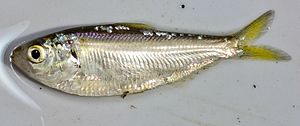Threadfin shad facts for kids
Quick facts for kids Threadfin shad |
|
|---|---|
 |
|
| Conservation status | |
| Scientific classification | |
| Synonyms | |
|
The threadfin shad (Dorosoma petenense) is a small freshwater fish that swims in open waters. It is often found in lakes, large streams, and reservoirs. You can find them in the Southeastern United States.
This fish is a "forage fish." This means it is a main food source for bigger fish. Like its cousin, the American gizzard shad, the threadfin shad has a long fin on its back. But the threadfin shad's mouth is different; it does not have a top jaw that sticks out.
The fins of the threadfin shad are often yellowish. This is especially true for its tail fin. Its back is grey or blue, and it has a dark spot on its shoulder. Threadfin shad like moving water. They usually stay closer to the surface, especially at dawn and dusk. They swim in large groups, sometimes with gizzard shad.
Threadfin shad can grow up to 8 in (200 mm) long, but this is rare. They are very sensitive to changes in water temperature and oxygen. Many of them die in late summer and fall. This often happens when the water gets too cold, around 42 °F. Many game fish love to eat threadfin shad. These include striped bass, largemouth bass, smallmouth bass, and catfish. Because they are such good food, people have moved them to many new places across the United States.
Contents
What Does a Threadfin Shad Look Like?
Adult threadfin shad can grow up to 7–8 inches (18–20 cm) long. Most of them have yellowish fins. They have a long fin on their back. There is also a dark spot on their shoulder.
Where Do Threadfin Shad Live?
Threadfin shad are originally from the U.S. They live west of the Appalachian Mountains. Their home range goes through the Mississippi River basin. It extends all the way down the Gulf of Mexico to Belize.
These fish do best in big lakes and rivers. When people build dams, they create more reservoirs. These new water bodies give the shad more places to live. Warmer temperatures in northern lakes have also helped them spread.
People have also moved threadfin shad to new areas. This was done to provide more food for other fish. Now, you can find them on the American West Coast. They live from Oregon south to San Diego Bay and the Gulf of California.
How Do Threadfin Shad Live?
Threadfin shad live in open water. They can be found in natural lakes, reservoirs, and large streams. They also live in slightly salty water, like estuaries and lagoons. They prefer areas where there are not many plants.
During the day, they swim in deeper water, up to 50 metres (160 ft) deep. At night, they move to shallower areas. Young and adult shad eat tiny living things called plankton. They also eat bits of dead plants and animals.
Many experts think that threadfin shad compete for food with young predator fish. This is especially true for young largemouth bass. But threadfin shad are also a very important food source for many game fish. These include the largemouth bass. They do not have many competitors for food. One fish that lives a similar life is the gizzard shad (Dorosoma cepedianum).
Threadfin Shad Life Cycle
Threadfin shad lay their eggs in the spring. This happens when the water temperature is around 60 degrees Fahrenheit. They are a schooling fish, meaning they swim in large groups in open water.
They usually lay eggs in the spring and early summer. Sometimes, they have a second time of laying eggs in early fall. They often lay eggs early in the morning. The eggs stick to plants and other things in the water. A female can lay between 2,000 and 24,000 eggs. Young shad can have their own babies when they are one year old. Most threadfin shad live for only 2 to 3 years.
Keeping Threadfin Shad Safe
People have moved many threadfin shad to northern areas. This has caused a problem. In winter, when water temperatures drop below 42 °F, many fish die. This affects both people and wildlife.
When many fish die, their bodies float to shore. This creates a bad smell that people do not like. It also changes how some birds eat. They start to rely on the dead fish for food. Experts say that these fish should not be moved to places where the water gets too cold. Luckily, threadfin shad are not endangered. There are many healthy populations of them.


